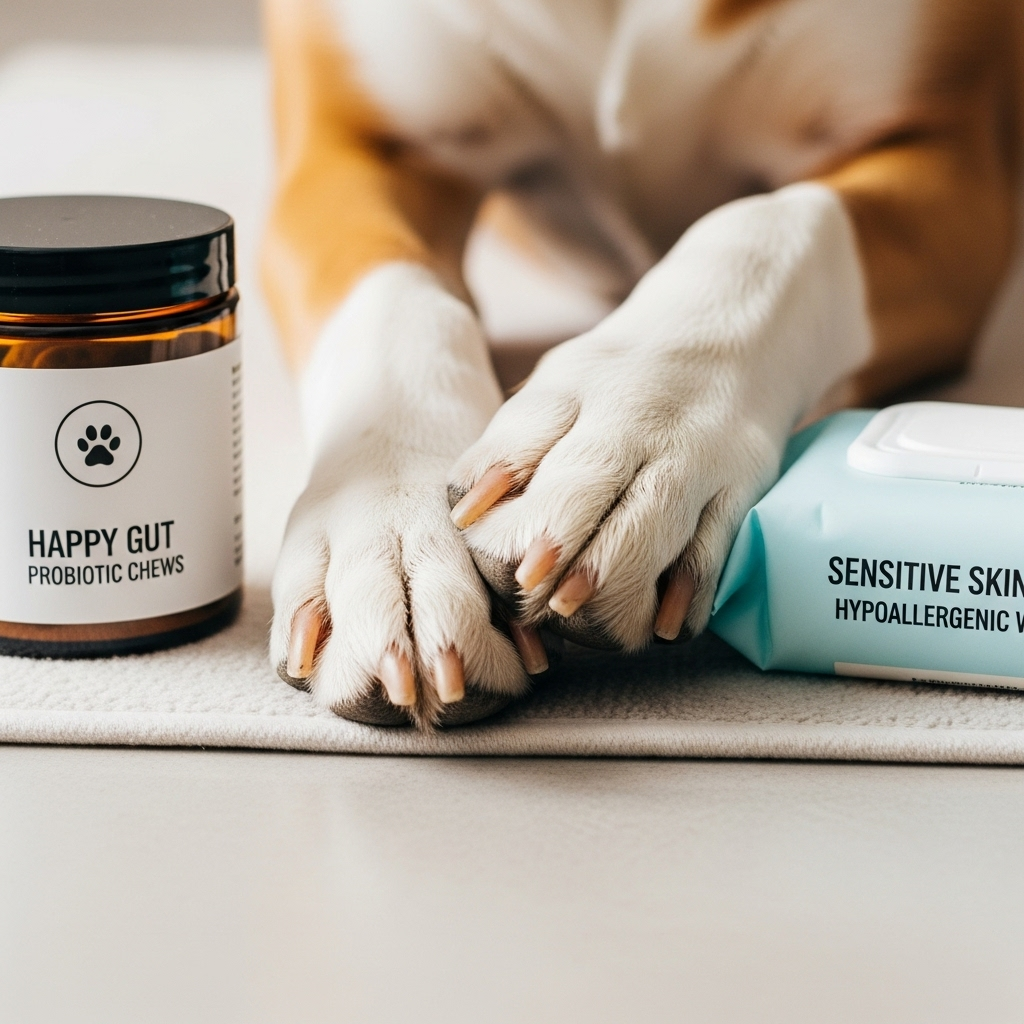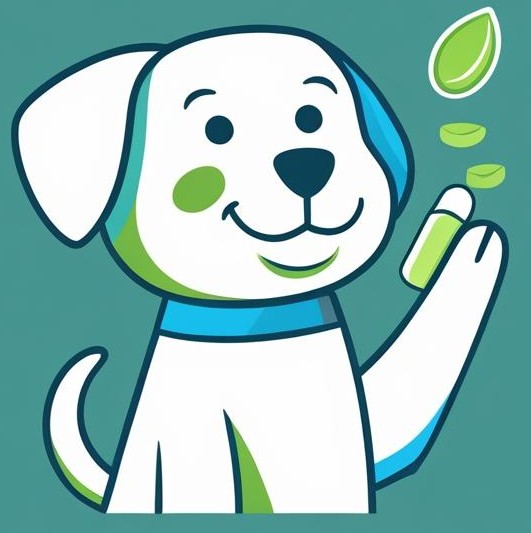Paw Licking & Yeast-Prone Skin: Probiotics for Dogs

Many dog owners wrestle with persistent paw licking and yeast-prone skin. These signs often point to underlying issues such as allergies, moisture, or microbial imbalance. This guide explains how probiotics can be used as part of a balanced approach — “probiotics for dogs paw licking yeast prone skin support” — to help manage symptoms, improve gut health, and support the immune system. It is written for pet owners who want practical, veterinarian-safe advice.
How paw licking and yeast overgrowth are connected
Paw licking is a common behavior in dogs. Occasional licking is normal, but chronic or obsessive paw licking with redness, odor, greasy or scaly skin often indicates yeast overgrowth (commonly Malassezia) or secondary infection. Factors that contribute include:
- Allergies (environmental or food)
- Moisture trapped in paws (frequent baths, swimming)
- Skin folds and anatomy that trap debris
- Antibiotic use or chronic inflammation that disturbs normal microflora
- Underlying immune or endocrine disorders
What probiotics can and cannot do
Probiotics are live beneficial microbes that support gut microbial balance and modulate immune responses. For dogs with paw licking and yeast-prone skin, probiotics can be helpful as part of a multi-pronged strategy:
- Support a healthy gut microbiome, which can influence skin health through the gut-skin axis.
- Help restore microflora balance after antibiotics, which may indirectly reduce conditions that favor yeast overgrowth.
- Potentially reduce inflammation and support barrier function by signaling to the immune system.
What probiotics will not reliably do:
- Probiotics are not a direct topical antifungal; they usually won’t rapidly clear a skin yeast infection on their own.
- They are not a substitute for diagnosing and treating underlying causes such as allergies, parasites, or hormonal disease.
Which probiotic strains to consider
Research in veterinary medicine suggests certain strains and species may be more helpful for dogs. Commonly used strains include:
- Lactobacillus species (e.g., L. acidophilus, L. rhamnosus)
- Bifidobacterium species
- Enterococcus faecium (commonly used in canine-specific products)
- Saccharomyces boulardii (a beneficial yeast used for gastrointestinal support)
Multi-strain products tailored for dogs are often preferred because they cover multiple mechanisms (colonization resistance, immune modulation, gut barrier support). Look for products that state species/strain and provide a guaranteed CFU count at the time of expiration.
Forms, dosing, and practical tips
Forms
- Chews and tablets: convenient for most dogs.
- Powders: useful to sprinkle on food for picky eaters or to mix with canned food.
- Capsules and sachets: allow precise dosing.
- Fortified foods or treats: check the guaranteed potency.
Dosing and duration
Follow the manufacturer’s instructions and your veterinarian’s guidance. Probiotic dosing varies by product, weight, and strain. Commonly products list daily CFU ranges; many canine supplements fall between millions to tens of billions CFU per day depending on size. Expect at least 4–8 weeks to evaluate meaningful changes for skin-related issues, and continue for longer if it helps.
Storage and handling
- Check whether the product requires refrigeration.
- Prefer products that guarantee CFU at expiry (not just at manufacture).
- Avoid giving probiotics intended for humans unless recommended by your vet; strains and doses can differ.
Integrating probiotics into a broader care plan
Probiotics are an adjunct; they work best alongside other targeted measures:
- Have your veterinarian rule out allergies, fleas, endocrine issues, or infections.
- Use medicated shampoos or topical antifungals when prescribed for active skin yeast.
- Keep paws dry: thoroughly dry between toes after baths or walks in wet conditions.
- Consider hypoallergenic or limited-ingredient diets if food allergy is suspected.
- Trim hair between pads and check for foreign material, nail problems, or interdigital cysts.
Potential risks and side effects
Probiotics are generally safe for healthy dogs, but possible side effects include mild gastrointestinal upset (gas, soft stools) when starting a product. In rare cases, dogs with severe immunosuppression or critical illness could be at risk for systemic infection from probiotic organisms. Always discuss with your veterinarian before starting probiotics if your dog has serious health problems or is on immunosuppressive drugs.
| Pros | Cons |
|---|---|
| May improve gut-skin health and reduce inflammation | Not a standalone cure for active skin yeast infections |
| Can help restore microflora after antibiotics | Results vary; may take weeks to months to see changes |
| Generally well tolerated in healthy dogs | Rare risk for immunocompromised animals; consult your vet |
How to pick a quality probiotic product
- Choose canine-specific products or those with published veterinary research.
- Look for multi-strain formulas with identified strains and guaranteed CFU at expiration.
- Prefer third-party testing or transparent manufacturing practices.
- Avoid unnecessary additives, artificial colors, or high amounts of sugars that could worsen yeast problems.
FAQ
- Q: Can probiotics stop my dog from licking their paws right away?
- A: Probiotics are unlikely to stop paw licking immediately. They may reduce underlying contributors over weeks, but immediate actions (drying paws, topical treatments, addressing infections or allergies) are often needed.
- Q: How long before I see an improvement?
- A: You may notice changes in digestion within days, but improvements in skin and behavior related to yeast or allergies typically take 4–12 weeks when probiotics are combined with other treatments.
- Q: Are human probiotics safe for dogs?
- A: Some human probiotics are safe, but formulations and doses differ. Use products labeled for dogs or consult your veterinarian before using a human product.
- Q: Can puppies take probiotics?
- A: Many probiotic products are formulated for puppies, but consult your vet for appropriate strains and dosing for young animals.
Key takeaways
- Probiotics can support the gut-skin axis and be a helpful adjunct for dogs with paw licking and yeast-prone skin.
- They are not a direct topical antifungal and should be used alongside veterinary diagnosis and targeted treatments.
- Choose canine-specific, multi-strain products with guaranteed potency and veterinary guidance.
- Expect several weeks to months before judging effectiveness; monitor for mild GI upset and consult your vet with concerns.
- Address environmental factors, moisture control, allergies, and proper topical care for best results.
If your dog has persistent licking, redness, foul odor, hair loss, or signs of pain, see your veterinarian for a full evaluation.
Disclaimer: This information is educational and not a substitute for veterinary care. Always consult your veterinarian before starting supplements or if your dog has persistent or severe symptoms, is pregnant, nursing, very young, elderly, or has pre-existing medical conditions. Your veterinarian can recommend the best diagnostic tests and a tailored treatment plan for paw licking and yeast-prone skin support.

Leave a Reply